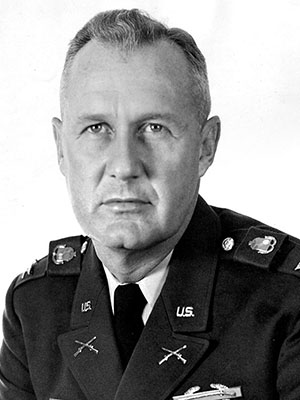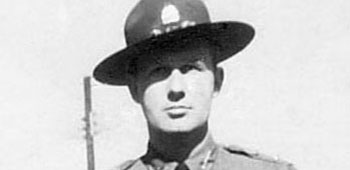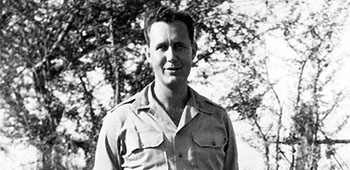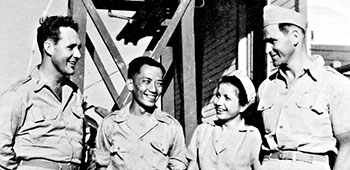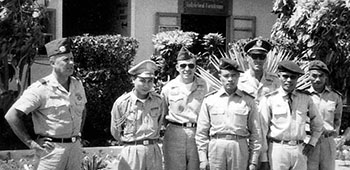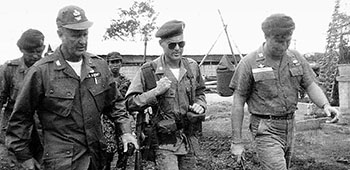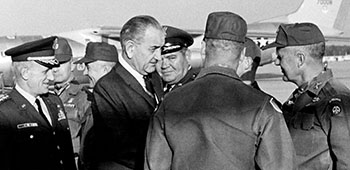Donald D. Blackburn was a true Army Special Operations Forces (ARSOF) pioneer. His service during World War II and in multiple tours in Vietnam placed him in the midst of many of the Army’s formative experiences in special operations. His keen familiarity working with indigenous groups and guerrilla forces made him one of the foremost experts in unconventional warfare. Throughout his career, he taught several generations of ARSOF warriors the crucial lessons he gained in combat.
Prior to World War II, 1LT Blackburn served as an advisor to a battalion of the 12th Infantry Regiment, Philippine Army. After the fall of Bataan in April 1942, he evaded capture and retreated into the mountains of Luzon to form a guerrilla force and carry on the fight. Already a seasoned trainer of Philippine troops, he served under the tutelage of Major Russell Volckmann and learned the intricacies of guerrilla warfare through trial and error. In an environment where unsuccessful guerrilla leaders did not last long, Blackburn excelled. By the end of 1943 he had expanded his intelligence networks and his unit became an important element of GEN MacArthur’s drive to retake the Philippine Islands in late 1944.
During and after the American landings, Blackburn’s guerrillas provided solid targeting information to conventional forces retaking the Philippines. They also conducted hit-and-run style attacks on select enemy targets. His force provided guides with thorough knowledge of the terrain and guerrilla troops that enabled U.S. combat units to decisively outmaneuver Japanese forces and gain advantage in the field. Blackburn’s guerrillas proved a valuable asset, and their services were actively sought out for some of the most difficult tasks.
In late 1945, when the remaining Japanese troops were defeated, the re-established and soon-to-be independent Government of the Philippines sought out LTC Blackburn’s assistance in rebuilding the Philippine Army. Blackburn’s solid combat leadership, technical expertise, intimate knowledge of the Filipino people, and keen organizational skills allowed him to quickly form and train military forces for the new government. Blackburn commanded the 11th Infantry (Philippine Commonwealth Army), which was integrated in October 1945 as a regular unit in the new Philippine military establishment.
Following World War II, LTC Blackburn served in various command and staff assignments. He became an Instructor in the Department of Military Psychology and Leadership, Tactical Department, United States Military Academy, West Point, NY, in 1950. In 1953, he attended the Armed Forces Staff College, Norfolk, VA. He was then assigned to the North Atlantic Treaty Organization (NATO), Allied Forces Northern Europe, Oslo, Norway.
On return to the United States in 1956, he was selected as Commanding Officer, 3rd Training Regiment, Fort Jackson, SC. In 1957, he reported to the Military Assistance Advisory Group (MAAG), Republic of Vietnam, where he served as the Senior Advisor to the Commanding General, 5th Military Region (Mekong Delta).
In October 1958, Colonel Blackburn was appointed as Commanding Officer, 77th Special Forces Group (which later became the 7th SFG), where he became instrumental in initiating Special Forces operations in Southeast Asia. Under his tutelage, the 77th SFG organized and deployed Special Forces soldiers to Laos as part of Project HOTFOOT, while simultaneously supporting combat operations in the Republic of Vietnam.
On graduating from the 1960 class of the National War College, Washington, DC, he served from 1961 to 1964 as the Deputy Director of Development for Special Warfare, Office of the Chief of Research and Development. In 1964 he was reassigned to the Office, Deputy Chief of Staff for Operations, as the Director of Special Warfare.
Dispatched to Southeast Asia, Blackburn became commander of the Studies and Observations Group (SOG), Military Assistance Command, Vietnam, from May 1965 to May 1966. On his return to the U.S., he was assigned as Assistant Deputy Director, Defense Communications Planning Group in Washington, DC, from August 1966 to August 1967.
From September 1967 to May 1968 he served as Assistant Division Commander for Support, 82nd Airborne Division, Fort Bragg, NC, before advancing to the Assistant Division Commander for Operations in May 1968. From October 1968 until August 1969, Brigadier General Blackburn served as the Director of Plans and Programs, Office of the Chief of Research and Development in Washington, DC.
He was appointed to the position of Special Assistant for Counterinsurgency and Special Activities (SACSA) under the Chairman, Joint Chiefs of Staff (August 1969 – June 1971). His responsibilities included advising the Chairman of the Joint Chiefs of Staff on covert action and military support for the Central Intelligence Agency. While SACSA, Blackburn was responsible for initial planning of Operation IVORY COAST, the attempted rescue of American Prisoners of War (POWs) at Son Tay, North Vietnam, and the selection of the leaders for that raid. He retired from active duty on 1 July 1971. As a civilian, he became Vice President, Special Projects for the Braddock, Dunn, and MacDonald Corporation, a defense contractor, until fully retiring in 1979. He died on 24 May 2008 at the age of 91 in Sarasota, Florida.
